
Click to enlarge
You know this photo; everybody does. It captures one of the signature moments in the career of Muhammad Ali, who died on Friday: his controversial first-round knockout of Sonny Liston in their heavyweight title rematch in May of 1965.
The photo also captures Ali’s signature look: red gloves (he also sometimes wore brown), white boots (hard to see in this shot, but they’re there), and, especially, the white trunks with black trim and the Everlast logo at 12 o’clock. When we think of Ali, this is how we instinctively think of him.
Or at least it’s how I think of him. I’m not old enough to have witnessed the first act of Ali’s career in the 1960s (the gold medal at Rome, the rise to heavyweight contention, his association with the Nation of Islam, his stunning upset of Sonny Liston to win the title, his first reign as champion, culminating in his title being stripped after his refusal to fight in Vietnam), and I have only sketchy memories of his transitional second act in the early 1970s (the comeback after the reinstatement of his boxing license, the losses to Joe Frazier and Ken Norton, the methodical dispatching of mostly lame opponents on the way to a title showdown with George Foreman). But I paid rapt attention to his third act. Of the 14 fights Ali had after reclaiming the title from Foreman in 1974, I watched six of them on live TV and caught most of the others when they were televised a week or two after the fact. He wore white trunks with black trim for all of them.
Still, there were exceptions to that rule during other parts of his career, the most notable of which was when he wore red trunks for his first bout against Joe Frazier in 1971 (the “Fight of the Century,” and Ali’s first professional loss). As I looked through the avalanche of Ali photos and videos that were circulating over the weekend in the wake of his death, I realized that the standard “white Everlast trunks with black trim” wasn’t quite as standard as I had thought. So I decided to track what Ali wore on a fight-to-fight basis.
I didn’t have time go to back through all 61 of his fights, but I started with his first fight with Liston in 1964 — the point at which he became a national and international star — and went from there. Of his 42 bouts from that point onward, I found that he wore his signature look — white trunks, black trim, Everlast logo — for 27 of them. The remaining 15 bouts are listed in this table:
[table id=29 /]
It hadn’t really registered with me until now that he wore Ampro during much of his first title reign (although not exclusively — he wore the standard Everlast look for several of those mid-1960s bouts, such as his three-round demolition of Cleveland Williams in 1966).
The other interesting thing is that he was more likely to wear something other than the Everlast logo in the early ’70s (when he hadn’t yet regained his title) and at the very end of his career (when he had lost the title again). All of which, I suspect, means he needed money during those periods and was more willing to sell that spot on his trunks, even to something like Williams Furniture (which was really sad, right?).
There’s one other thing about Ali I want to bring up. If you go back and look at that photo at the top of the page, he’s yelling at Sonny Liston to get up. Right after that, however, he began dancing around Liston’s fallen body and refused to go to — or remain in — a neutral corner, which led to chaos in the ring and is one of several things about the fight’s outcome that remain controversial to this day.
It was, in short, a classic “Look at me!” moment, a triumph of narcissism over professionalism. Or to put it another way, it’s precisely the sort of behavior many of us can’t stand about so many contemporary athletes.
Ali was arguably the wellspring of that behavior in modern sports. Even as a kid, I found this aspect of him to be a turn-off — not because he was an “uppity black” or a political agitator (which is certainly why so much of the white establishment disliked him) but simply because he so often seemed to choose self-aggrandizement over dignity, hubris over humility, id over superego, all of which I found distasteful. I rooted against him in all of those fights I watched while growing up.
I later came to appreciate him on other levels, of course, and I can see now that he was a much more complicated character than I realized at that time. He clearly was a narcissist, with a constant craving for adulation and attention that often seemed childish. He also had some moral blind spots that I think have been bulldozed by the legend of his greatness. Mostly, though, I think Ali just liked to have fun, and the surest avenue to fun that he knew of was himself. It’s captured perfectly in his famous “world’s shortest poem”: “Me? / Whee!”
There’s an old Sonny Boy Williamson blues tune called “Clowning with the World,” and I think that title nicely captures Ali’s spirit. He was always clowning with all of us. It didn’t hurt that the three signature opponents of his career — Sonny Liston, Joe Frazier, and George Foreman — were all witless dullards by comparison (this was long before Foreman’s self-reinvention as a loquacious, self-effacing TV pitchman). Ali was able to run rings around them not just in the boxing ring but in the media and in the public imagination, turning them into foils while casting himself as Bugs Bunny to their Daffy Duck.
Obviously, Ali’s affliction with Parkinson’s was a terrible thing. But if there was a positive aspect to it, it’s that the disease essentially pulled the plug on his “Look at me!” side, leaving his good deeds free to speak for themselves: the U.N. peace missions, the charity work, the hospital visits. If you’ve ever seen any video of Ali with children, it’s clear that he loved them, and the feeling was mutual, even among kids who had no idea who he was. I always thought that spoke well of him.
And no matter what one thinks of the “Look at me!” school of sports behavior, I think even the most hardened critic would have to admit that of all the athletes who ever said, “Look at me!,” Ali was the one most worth looking at. R.I.P.
And while we’re at it…: That photo at the top of today’s entry marked a signature moment for someone else besides Ali. It was a benchmark in the career of the great Neil Leifer, the photographer who took the shot. Incredibly, Leifer was only 22 years old at the time.
I love that photo — who wouldn’t? — but the Leifer shot of Ali that I really love is this next one, taken from the rafters of the Astrodome during Ali’s 1966 fight against Big Cat Williams (do yourself a favor and click to enlarge):

So much to like there, especially the symmetry of the fighters’ raised arms. Leifer has said that it’s his favorite shot, and it’s reportedly the only one of his photos that he displays in his own home.

Click to enlarge
Throwing way back: Lots of buzz yesterday among Ohio State football fans regarding the photo above, which was taken by the father of a recruit during a visit to the school’s training facility (further info here). It appears to be based on this OSU uniform from the late 1910s.
This could be just a shiny object to dangle in front of recruits. But Andrew Lind, who tends to get these things right, says this is indeed the Buckeyes’ new alternate uniform. So there you go.
In a related item, Lind has created a new website devoted to Ohio State’s uniforms — good stuff.

Photo by Mary Bakija; click to enlarge
Birthday gift that keeps on giving: As some of you may recall, longtime reader/pal/neighbor Marty Buccafusco gave me a gigantic pinbone steak for my birthday back in March. I promised to grill it with him when the weather and our schedules allowed. This past Saturday was that day, as Marty and his wife, Jesse, and their son, Gus, joined me and the Tugboat Captain in the backyard.
The steak didn’t have much marbling (based on the butcher Marty got it from, it was probably grass-fed, which tends not to yield much marbling), but that was okay, because it had clearly been dry-aged for a long time. That dry-aged flavor — a distinct mineral funk — came through with every bite. Sooooo good (for all photos, you can click to enlarge):
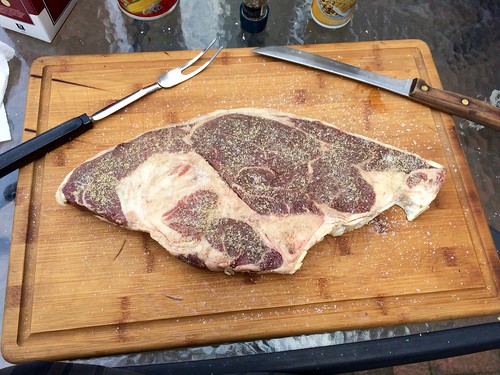
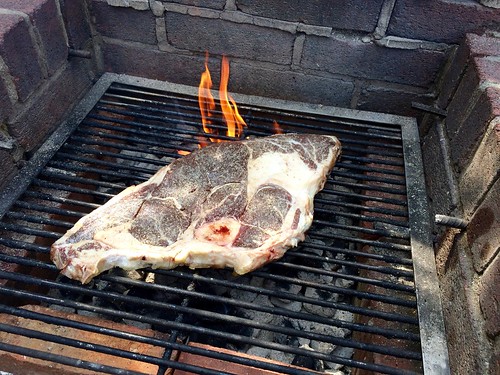
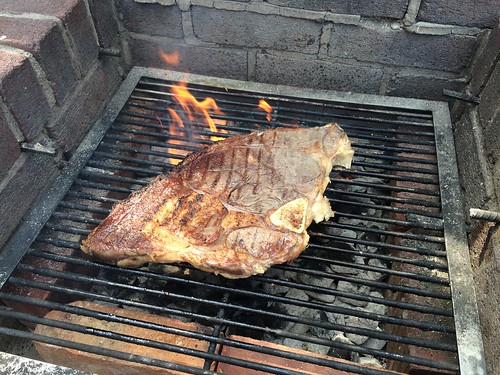
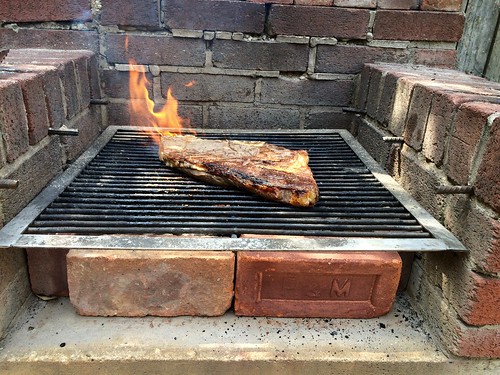
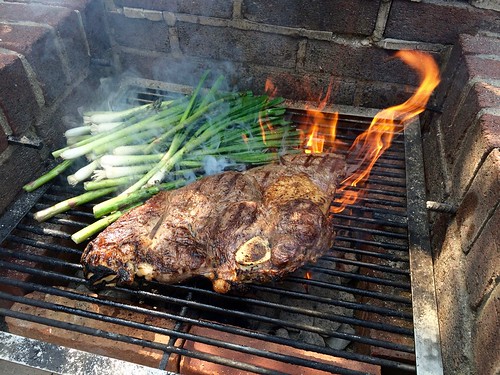
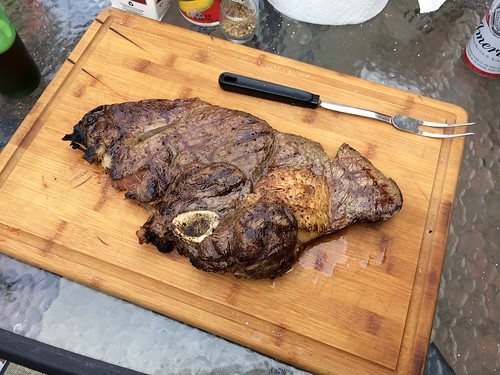
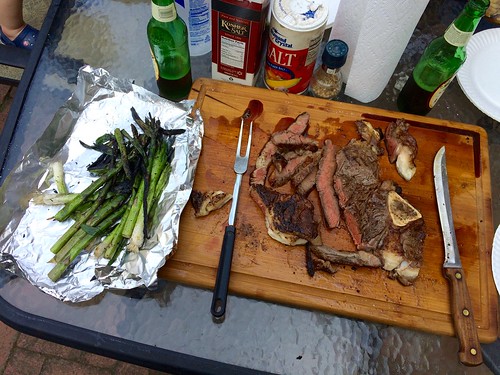
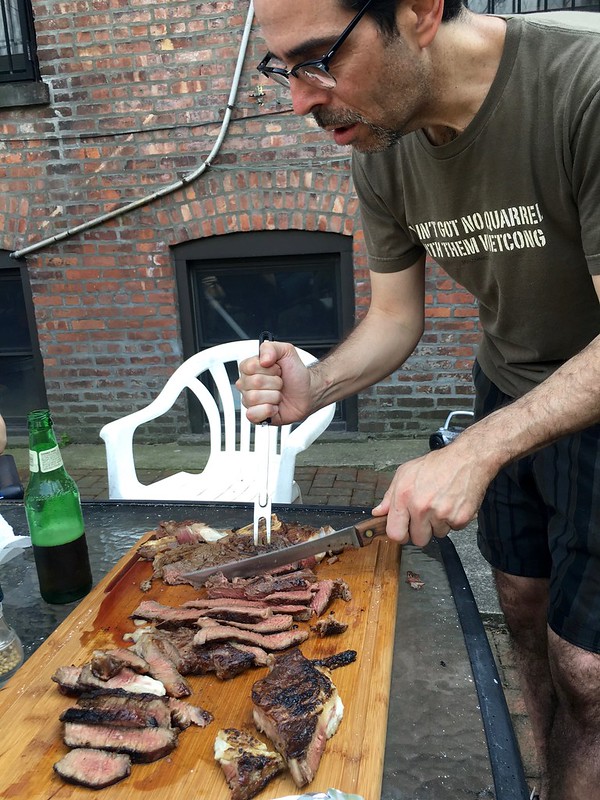
As you can see, I actually overcooked it a bit, at least by my usual standards, but it was still sensational. Thanks so much for the great gift, Marty, and for helping me to extend my birthday into June — you’re the best.

KRC update: The latest installment of Key Ring Chronicles involves a brass cotter pin that used to be attached to a gym locker key. Check it out here.
The Ticker
By Alex Hider

Baseball News: History was made yesterday, as two MLB teams wore pillbox hats on the same day for the first time in 40 years (from Ken King). … The Indians and Royals went blue-on-blue for the second straight day, this time with modern unis (from Jeremy). … Phil pointed out the other day that many Phillies wore red socks with darker maroon throwbacks. What’s worse was the Phils gave away true maroon socks to fans during the game (from Michael Lipinski). … Another thing missing from the Phillies’ throwbacks: radially-arched NOBs (from Frank McGuigan). … The Cubs’ mascot may not wear pants, but he was wearing sunglasses and a custom jersey yesterday (from Dan Sagerman). … Louisville wore “Ali” on the side of their caps as a tribute to Muhammad Ali (from Tim Johnson). … SE Louisiana wore some classy unis complete with placket lettering during the College World Series regionals (from Josh Claywell). … UNC Wilmington wore some sexy teal-striped stirrups yesterday (from Brian Love). … James Jones of Rangers affiliate Round Rock Express was wearing pants with the MLB logo on the belt tunnel (from Malcolm MacMillan). … Dan Bewley passed along an interesting photo from the Oklahoma Historical Society. Are those primitive shin guards pictured in the bottom right of the photo, or is it a chest protector? Anyone have any more info? … Hmmm, why was Cubs P Jake Arrieta wearing a cap with the MiLB logo following yesterday’s game? … An NYC softball team — Team Scotch — has had uniforms patterned after the Astros, Mets, and Expos (from Brian Byrne).

Hockey News: Did anyone else catch Joel Ward clipping his fingernails after scoring the tying goal in the third period of Game 3 of the Stanley Cup Finals on Saturday? I know Mike Bibby used to do this on the bench when he played in the NBA, and nail clippers are common in MLB bullpens, but is this the first time we’ve seen this in hockey? … Bay Area native Marshawn Lynch supported his Sharks this weekend in a custom “Beast Mode” jersey. … Awesome photo of the 1967 NHL expansion goalies (from Chris Burks).

Soccer News: Wondering what’s written on the back of Ecuador’s Copa America kits? Apparently, it says “forjados en la historia,” which means “forged in history.” (From @yellawkt.) … Not many teams in MLS have third kits, but Josh Hinton points out that the LA Galaxy have a pretty nice gold throwback. He also sends along new kits for Birmingham City and Cardiff City.

Grab Bag: Looks like a European basketball team confused Arabic and Roman numerals (from Adam Mangus). … The Philadelphia Eagles held a basketball event this weekend, and wore custom uniforms to boot. Too bad they were BFBS (from Jack Connell).
Paul,
The line about “Paraguay’s Copa America kits” is really about Ecuador
Fixed.
Soccer ticker
That’s not Paraguay, it’s Ecuador
Is there something to both pillbox teams being from Pennsylvania?
No.
Not disagreeing with BurghFan but I recall pillbox hats being worn primarily by National League East teams back in 1976; especially the Pirates, Phillies and Cardinals.
I do not remember most National League West or any American League teams wearing pillbox hats.
Mets had one as well.
Ebbets Field Flannels is selling a Tidewater Tides pillbox cap in Mets colors. It’s pretty snazzy!
I’m pretty sure (and Okkonen’s guide shows) the Reds had a pillbox – I can’t specifically remember them wearing it, but it’s there.
Did the Phillies wear the pillbox at home? I seem to remember it being a road thing, like the Cardinals, but again, don’t specifically remember.
Paul, typo alert: in the second paragraph you’ve got “white trucks ” when you want “white trunks”.
Also, I love that T-shirt you’ve got on in the barbecue photos!
Ugh — thank you. Now fixed.
As you can see in the first of the backyard photos, Marty and I had a common theme with our T-shirts on Saturday.
I love red color T-shirt in which 47 is written.
Nail clippers in hockey? Sure, Dominik Hasek insisted on having a pair velcro’ed to the wall of his locker.
“…even the most hardened critic would have to admit that of all the athletes who ever said, ‘Look at me!,’ Ali was the one most worth looking at.”
Amen, Paul. You hit the nail on the head.
As you mentioned, despite the terrible nature of his affliction, it was wonderful that the world got to see the true Ali once the ego was cast aside. Everyone thought they loved him for his personality. Turns out they loved him for his humanity all along.
Nicely put, Marc, esp. those last two sentences. Wish I’d thought to phrase it that way myself!
Another way to look at it is that he had a humanity worth loving – but prevented us from seeing it by letting his personality/character steal the show.
Not sure how Paul or his loyal following feel about this, but I think the NCAA baseball tournament brings out an incredibly varied assortment of uniforms. You’ve got throwbacks (SE Louisiana as described above), traditional, future looking and some just plain odd. Your thoughts? By the way, I think my favorite college jersey this year was the dark gray Tennessee (though it didn’t help the Vols get into the tournament).
Great work today, Paul. I hafta admit, I always found the self-aggrandizement tiresome as well. But man, the Bugs/Daffy analogy is spot on.
Anyone notice that the Team Scotch logo on the Expos jersey is an elephant leaving an “Upper-Decker”?
link
I didn’t notice that but glad u caught it and pointed it out. Brilliant!
Grilled asparagus and beef is a match made in heaven, looks great!
Great reading today, Paul. My favorite story about Ali was when a stewardess asked him to fasten his seat belt before takeoff. Ali said “Superman don’t need a seatbelt!” To which she replied “Champ, Superman doesn’t need an airplane.”
I don’t think equating Ali’s “look at me” shenanigans to athletes doing the same thing in team sports is entirely fair. It’s one thing for a wideout to act like he scored a TD all by himself without the QB or his blockers, but boxing is a completely individual sport (granted, there is a ‘team’ in the corner, but only one guy is taking the punches). So I don’t begrudge fighters for wanting to talk themselves up, least of all Ali (because he did it best). And it’s as much a psychological attack as anything else. The fight is more than just the 12 rounds in the ring; it’s the weeks and months leading up to the fight where a fighter can get a mental edge over his opponent as well.
Plenty of sports are about “more than just the xxxxx in the ring/field/court/etc”. I don’t think we should excuse self aggrandizement – especially when it is done in a manner that disrespects your opponent – in any sport. We spend years telling children about the importance of showing good sportsmanship.
Its interesting that the athlete we revere the most for their support for human rights, is also the most notable trash talker of all time.
I think “good sportsmanship” pretty much ends the moment that those playing are being paid for it.
Are you observing that it tends to end because being paid inevitably affects people’s behavior?
Or are you arguing that it *should* end once the athletes are paid?
Just an observation on human nature. Once money is involved, a game inevitably transitions from “fun” into something else.
Bingo. I’ll always have a problem with those who demand respect, yet offer none in return.
Completely wrong – they promoting themselves
I have a question I have meaning to ask about Ichiro Suzuki and his name on the back of his jersey. Why is it his first name and not his last name?
When Ichiro was in the Japanese minor leagues, he was on a team that include two other players who were all surnamed Suzuki.
All three of those players wore their first names. Only Ichiro made it to the Japanese majors, where he continued to wear his first name. When he joined the Mariners, he and the Mariners requested permission from the MLB office for him to keep wearing his first name. The request was granted.
That’s similar to one of the reasons Brazilian soccer players don’t have their last names on their jerseys, as four surnames account for 25% of the population.
I not only think of Ali wearing Everlast not just because of the Neil Leifer photo of his second fight with Liston, but because of Carl Fischer’s equally iconic Esquire magazine cover of Ali as St. Sebastian. (See link)
I didn’t mean to suggest that the Leifer photo was *why* we think of this as Ali’s signature style; I just meant that it captures (as do many other photos, including the one you mention) what we think of his signature style.
Ohio States Chic Harley era alternate is a great idea. But the result is disappointing. As for accuracy that is. Why the huge number covering the strips???
Pants would have been tan or khaki also.
I think NCAA rules probably require the number to be there. Kinda like the NFL and the Packers throwbacks with the circle on the front being like 4 times it’s original size.
I think so too. Just wish it was not so big and blocking the strips.
I mean, it’s got to be a certain size, so there’s really no other option.
Ali’s self-promotion never bothered me. I think it was Dizzy Dean that said “it isn’t bragging if you can do it”.
Self-aggrandizing by mediocre athletes on mediocre teams is what’s tiresome.
“it isn’t bragging if you can do it”
Actually, it’s still bragging. It just happens to accurate or factual.
Arrieta was wearing a South Bend Cubs hat after the game yesterday, I follow the Cubs on Snapchat and it was 100% visible. Cool to see the guys in the majors supporting the minor league guys!
That LA Galaxy third is not going to be worn on the field
The Galaxy’s gold throwback jerseys were only used as warm-ups for throwback day.
link
A side note about Leifer’s photo is the photographer across the ring between Ali’s knees. His name escapes me, but I believe he worked for Time, and made a big deal out of having first pick for his “spot” at ringside, and there he is, staring blankly with no picture to take.
Any ringside spot is a good one — unless the fight ends in the first round, like this one did. That’s another amazing thing about Leifer’s shot: A photographer at a typical fight would shoot many rolls of film (yes, film in those days) and have lots of opportunities to get a good shot, but this fight was a photographer’s worst nightmare — a first-round KO. Very limited window of opportunity for the fotogs.
The photos you shared were more action-packed, but this is my favorite Neil Leifer photo of Ali:
link
For two reasons I do not buy Paul’s subtle equivalency between Ali and today’s athletic self-promotion. Well, three reasons, but the third is trivial: It is simply false that Ali was a trailblazer in this regard. But that aside, two serious objections. First, boxing is an individual sport, and it has always been the case that professional athletes in individual sports have been self-promoters. It’s not as though Walter Hagen and Rocky Marciano were shy, humble, models of gentlemanly self-effacement. What they were was not black, which gets to my second objection. In the early professional era and during pro sports integration, black athletes were expected – both by dominant norms of white culture but also by the norms of black culture at the time – to represent their race by the highest standards of decorum. Thus the examples of Jack Johnson and Jackie Robinson – black men who so completely subsumed their blackness and masculinity in public that white men didn’t feel threatened by them. Ali represents a post-Jackie, indeed post-MLK, embrace of blackness and of black masculinity. He was of a piece with the “black power” movement. For Ali to say “look at me” was not just any punk athlete saying “look at me,” it was a black man in the public eye forcing the white American public to see his blackness.
When an athlete on any top-level pro team today engages in look-at-me antics, he’s just being an immature asshole. When Ali engaged in look-at-me antics, he was engaging in a heroic and necessary act of political and cultural resistance – and also acting out an only slightly exaggerated version of what was even in his time normal behavior for white athletes in individual sports.
Although all that said, I’m almost exactly ten years younger than Paul, so Ali was never really an athlete for me. He was an already established, mostly already retired, cultural presence, and my boxing-fan dad’s favorite athlete. (Well, Ali and Musial.) For me, Sugar Ray Leonard was the one and only boxer I ever really was a fan of. And Sugar Ray was self-consciously market-driven anodyne, a sort of anti-Ali, or even a sort of proto-Jeter. Which, looking back, makes me appreciate Ali’s “antics” all the more.
Well said!
So, if, during the early days of sports integration, a black athlete carried himself with dignity and humility, he “completely subsumed (his) blackness and masculinity in public”? I wasn’t aware that these were racial traits.
How hard would the struggle have been if, say, Jesse Owens comported himself like Ty Cobb?
I’d rather not see anyone comport themselves like Ty Cobb.
Didn’t you know? Stereotyping is okay if you’re doing it benevolently?
About the race thing:
1) I’m aware, of course, that the standards of professionalism and decorum that Ali routinely “violated” were essentially the standards of the white establishment. But it’s absurd to suggest that not going to and remaining in a neutral corner after a knockdown was some sort of radical and/or creative act of nonconformity. It was unprofessional, immature, and selfish, period, and it had a material effect on the fight’s outcome. Not all of Ali’s conduct sank to this level, but not all of it can simply be written off as black pride either.
2) I specifically avoided talking about Ali and race today (aside from a quick parenthetical) because the intersection of Ali and race was complicated and often ugly. Repeatedly calling Joe Frazier a gorilla, calling him ignorant, pushing down his own nose to caricature Frazier’s more Negroid features – this was disgusting, racist stuff, and completely indefensible. He made it worse by laughing it off as his way of ginning up the box office. (Side note: Frazier had loaned Ali money during his exile.) Similarly, when preparing to fight Foreman in Zaire, he argued to fans that only he, Ali, was a true African — not Foreman, whom he labeled “a Belgian.” Again, ugly stuff, especially from someone who identified with black nationalist politics.
And that’s not even getting into all the “Uncle Tom” accusations.
Ali was a hero to black America, and rightly so. But he also treated some other black fighters very, very poorly. I decided not to get into any of that in today’s lede. Which is why I also didn’t get into the ways he was racially heroic.
One thing’s for sure: He was too big for one blog post!
Paul, you overcooked the meat!
Yes. I said as much in the text.
More for me!
It’s kind of funny that just last week I referenced that photo of Ali towering over Liston as one of the 10 works of art that I found especially inspiring.
A couple years ago, the Annenberg Space for Photography here in LA had an exhibit of photography from Neil Leifer and Walter Iooss, Jr. Of course both of the Leifer photos Paul referenced were on display, as well as one of my all-time favorite sports photos – Steve Cauthen posing on a scale before riding Affirmed. It looks like something out of a Norman Rockwell painting.
Walter Iooss has his fair share of iconic photos, including several well-known shots of Michael Jordan and a rather menacing looking Bernard Hopkins, but his best known photo is The Catch.
The entire exhibit was a photographer/sports fan/Uni-Watcher’s dream and one of the most enjoyable art exhibits I’ve ever seen.
Sorry – meant to add that, tying in to today’s story about Ali, Walter Iooss also took this brilliant shot of Ali and Frazier.
link
When he was still Cassius Clay, the Greatest admitted that he stole the shtick of Gorgeous George (Google him) to gin up interest in his upcoming bouts. And it worked.
I was hoping to find something about Ali’s trunks on Uni-Watch today and loved it. I to also was associate Ali with white/black-trimmed/Everlast so it was very interesting to read. As for Ali the character/personality I have a somewhat different view of things than Paul and most of today’s commenters so far since Ali fought his last fight 7 years before I was born. I don’t really have any issue with Ali’s self-aggrandizement, but I grew up with Ali the legend as opposed to Ali the active competitor. I will say that I think the fact that Ali was a black man combined with the start of the overproliferation of mass media played a huge part in Ali being considered the “wellspring” of that kind of behavior. There were Major League Baseball players who did thing at the beginning of the century that made today’s “look at me” behavior seem like nothing. However there were fewer eyes in the park to look and no way for anyone not there to see it.
As for the steak, the recipe and cooking method makes it sound delicious, but “overcooked” isn’t at all how I’d describe it. ;)
Paul,
The most honest look at Ali’s legacy I’ve seen since his passing. Respectful, and full of admiration for his abilities, and courage both in and out of the ring. But not sugar coated like all the rest. Well done.
As a longtime bbq guy (charcoal rules!), I really like your grill setup! Steak looks fine, plenty of pink left there…
Real charcoal at that. None of this briquette jibber jabber. Burnt to a crisp on the outside and pink on the inside steak is manna from heaven.
Sorry to burst your bubble, Jon, but that’s Kingsford!
I’m a hardliner when it comes to charcoal vs. gas. Also a hardliner for using a chimney vs. lighter fluid (and let’s not even discuss MatchLight and the other insta-light products, which are beneath contempt). Not so hardline when it comes to briquettes vs. lump, however.
Lump is more expensive and burns thru much faster (which means it’s even more expensive than it initially seems). It can also burn *too* hot sometimes, at least for me. Briquettes aren’t perfect, and I know they have chemical binders and such. But I find that they’re fine for my purposes.
I realize a lump purist would disagree, and I respect that position.
I find briquettes inadequate for that burnt/pink finish that I mentioned. Only lump gets hot enough for me. I agree, however, on the use of a chimney. Lighter fluid belongs in a Zippo, not a grill.
Thanks, Sandy — appreciated.
Boxing is even more prone to mythmaking than the other sports, and Ali’s myth is the strongest of them all. He was a truly important figure in human history, and in many ways he was Great. But he was also flawed (as most of us are), sometimes badly. I’ve been wrestling with how to balance those aspects of his character for many years. Today’s entry provided a little peak at that internal wrestle.
Funny you should state that “He was always clowning with all of us.”
link
RSB
Paul: Great article about Ali’s choice of trunks. I think you missed the pair of trunks he wore for gphis first Floyd Patterson fight. It appears that he was wearing gloves and trunks with the brand “Frager” on them. The reason I looked is because I actually have a signed pair of trunks from Ali that my Dad got from a friend of Ali’s – we grew up a few miles from his training camp in Deer Lake PA. The trunks I have are signed by Ali and dated Oct 2, 1972 just a few weeks after his second Patterson fight. I didn’t come across any other photos of Ali fighting in “Frager” trunks. The Frager trunks were of course white with black trim.
Ah, good call. I did look at pics of that fight. But because the Frager logo was bowtie-shaped, similar to Everlast logo, I mistakenly thought it was Everlast. Thanks for setting me straight!
Here’s a shot from the fight:
link
And here’s a pre-fight shot from Ali’s dressing room:
link
I’ll add that to the table in today’s entry.
That’s a really good point about boxing, how many brands have adopted that bow tie shape for logos. Even Tapout in MMA is based on it. I assumed it all copied Everlast but not sure since I don’t know much about boxing.
Nobody noticed Paul’s “Ain’t got no quarrel with them Vietcong” shirt?
Actually, Steve, someone else mentioned it in an earlier comment.
Can you tell us where you got the shirt?
It was made by No Mas. No longer available, according to their website.
The cavs Blue Alternates are so gross, they have a Beautiful set, white, wine, and gold. I HATE the blues, they need to be wearing more classic look in the Finals also, not their alternates
YES
Thanks. I will write them. They are usually pretty good about responding.
The Browns used to play the Steelers in a charity basketball game at my HS way back when. They always had nifty uniforms. Wish I had a pic.